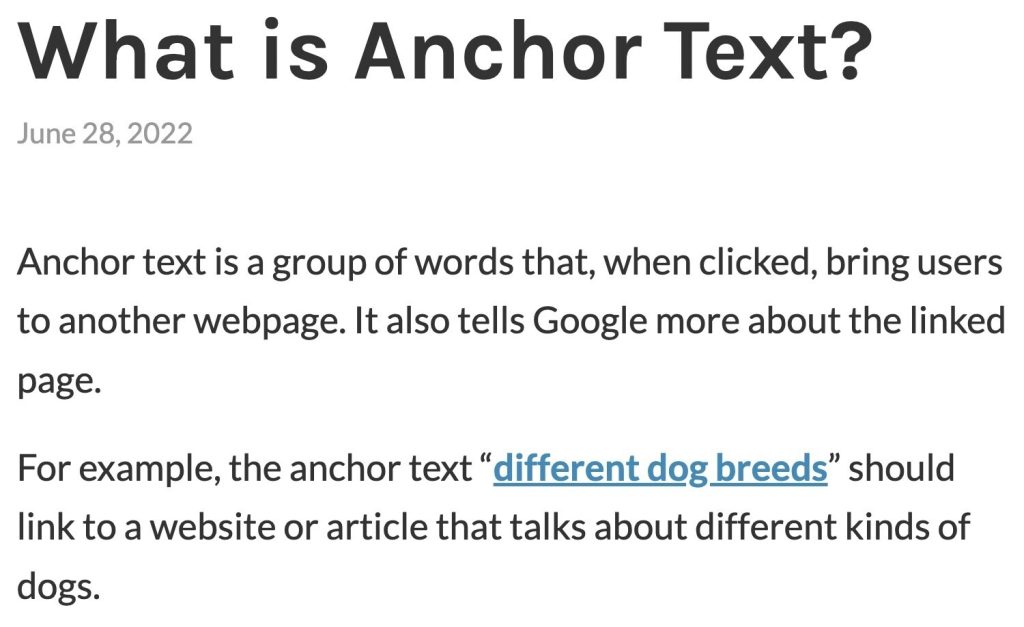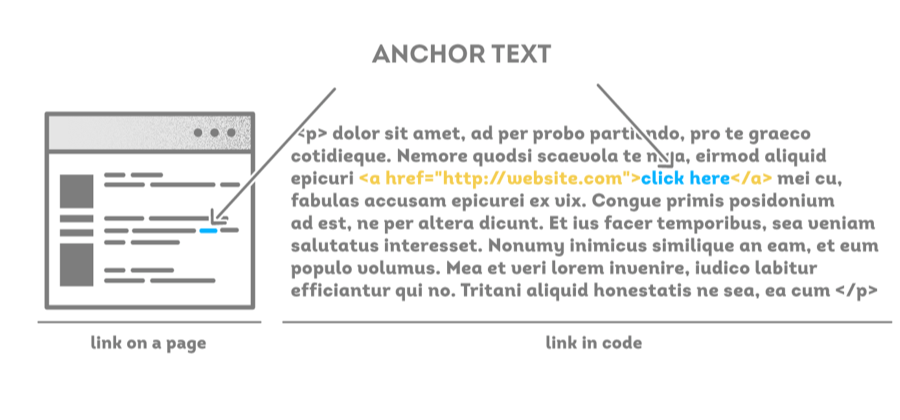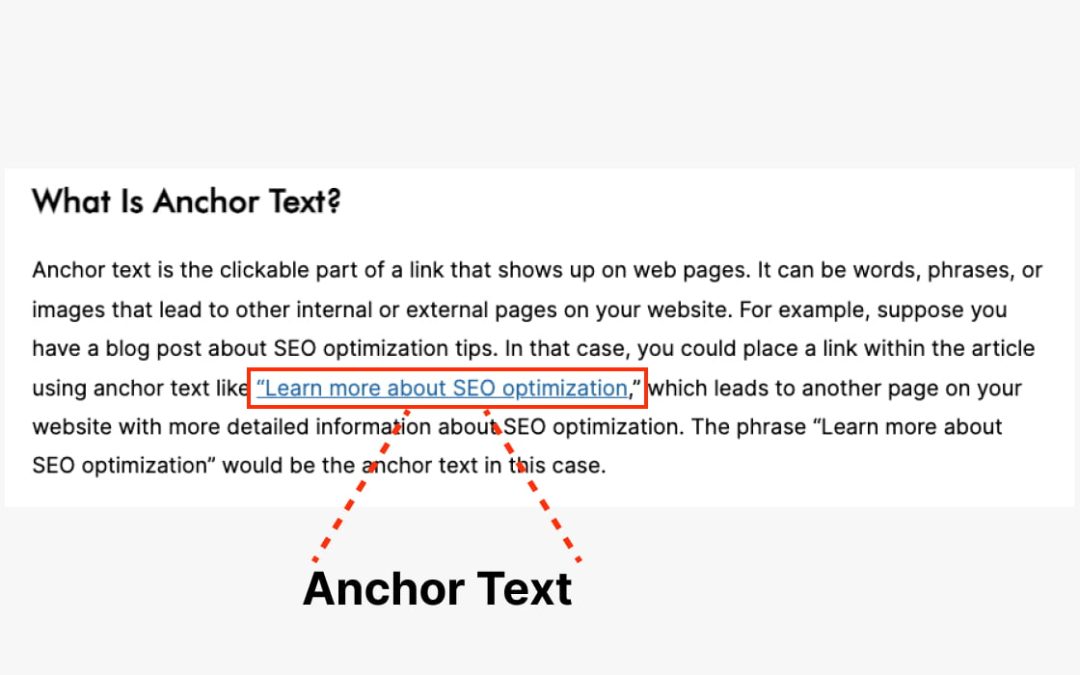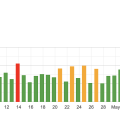If you’ve ever delved into the world of SEO or just clicked on a hyperlink, you might have encountered something called anchor text. In its simplest form, anchor text is the clickable words in a hyperlink that guide you to another webpage or a different section within the same page. It’s not just a plain element of web design; your anchor text can significantly impact your page’s ranking on search engines, influence reader engagement, and provide contextual relevance. So, what is anchor text? Let’s break it down and understand why it matters for your online presence. Ever come across a hyperlink online and wondered what exactly it’s called or why it’s important? If yes, then you’re in the right place! We’re diving deep into the world of anchor text—demystifying what it is, why it matters, and how you can use it effectively. So, buckle up and let’s explore!

What Is Anchor Text?
Anchor text is essentially the clickable text in a hyperlink. It typically appears in a different color, often blue, and is sometimes underlined. When you click on this text, it leads you to another webpage. For instance, if you see text like “click here” or “learn more,” that’s anchor text.
Why Is Anchor Text Important?
The significance of anchor text extends beyond just its clickable nature. It plays a crucial role in both user experience and search engine optimization (SEO). Good anchor text provides users with context about the linked page, enhancing their browsing experience. Additionally, search engines use anchor text to determine the relevance and importance of the linked page.
Types of Anchor Text
Anchor text isn’t one-size-fits-all. There are several different types, each serving its own unique purpose. Let’s take a closer look:
Exact Match Anchor Text: This type includes keywords that exactly match the content it’s linking to. For example, if you’re linking to a page about “SEO tips,” using “SEO tips” as your anchor text is an exact match.
Partial Match Anchor Text: These also include keywords but are not an exact match. If your link is about “SEO tips,” using “best SEO strategies” would be a partial match.
Branded Anchor Text: This type uses the brand’s name as the anchor. For example, linking to Apple’s website using “Apple” as the anchor text.
Naked URLs: This type displays the actual URL instead of text. For instance, instead of using descriptive text, you simply display “https://example.com.”
Generic Anchor Text: These are general terms like “click here” or “read more.” While useful, they don’t provide specific context about the linked content.
Image Anchor Text: When images are used as anchors, the alt text of the image serves as the anchor text.
| Type | Description | Example |
|---|---|---|
| Exact Match | Keywords match linked content | SEO tips |
| Partial Match | Keywords are similar but not exact | best SEO strategies |
| Branded | Uses the brand name | Apple |
| Naked URLs | Displays the full URL | https://example.com |
| Generic | General terms | Click here |
| Image | Uses image as anchor with alt text | (Image with alt text “SEO strategy”) |
How Anchor Text Affects SEO
You might be wondering how something as simple as clickable text can influence SEO. Well, it’s all about how search engines perceive relevance and credibility.
Relevance and Search Engines
Search engines use anchor text to understand what the linked page is about. If numerous sites link to a page using the same relevant keyword, search engines will deduce that the page provides valuable content about that keyword.
Anchor Text Best Practices
To maximize the effectiveness of your anchor text, consider the following best practices:
- Keep It Relevant: The text should be relevant to the content of the linked page.
- Use Keywords Wisely: Incorporate keywords naturally without overstuffing.
- Diversify Anchor Text: Avoid using the same anchor text repeatedly. A diverse anchor text profile looks more natural and is beneficial for SEO.
- Consider User Experience: Ensure anchor text adds to the user’s understanding and enhances their experience.
The Role of Anchor Text in Link Building
Effective link-building strategies often hinge on the quality and relevance of anchor text. When you’re soliciting backlinks, gently guide your partners on the most appropriate anchor text. For instance, if you’re an SEO consultant, you might suggest that they link to your site using terms like “SEO consulting services” rather than generic phrases like “learn more.”
Common Mistakes and How to Avoid Them
Even seasoned webmasters sometimes make mistakes with anchor text. Here are some pitfalls to avoid:
Over-Optimization
While it’s tempting to stuff your anchor text with keywords, overdoing it can have the opposite effect. Search engines may penalize your site if they detect an unnatural, overly-optimized pattern.
Using Only Generic Text
While phrases like “click here” are widely used, relying solely on generic anchor text doesn’t offer much value in terms of SEO. It’s essential to vary your approach to provide more context.
Understanding Anchor Text and PageRank
Google’s PageRank algorithm was one of the first to use anchor text as a significant ranking factor. PageRank essentially measures the “importance” of webpages based on the incoming links. If high-quality sites link to your site using relevant anchor text, it boosts your PageRank, thereby enhancing your search engine rankings.

Tools and Techniques for Analyzing Anchor Text
Using the right tools can help you analyze your anchor text strategy and make data-driven improvements. Here are a few tools you might find useful:
Google Search Console
This is a free tool from Google that provides you with insights into how your site performs in Google Search, including detailed information about your anchor text.
Ahrefs
Ahrefs is a popular SEO tool that offers a comprehensive analysis of your backlink profile, including anchor text.
SEMrush
SEMrush is another excellent tool that provides detailed reports on your anchor text usage and overall link-building strategy.
How to Get Started with Anchor Text
So, you’re convinced about the importance of crafting effective anchor text, but where do you start? Here’s a step-by-step guide:
- Audit Your Current Anchor Text: Use tools like Google Search Console to assess your current situation.
- Identify Weak Spots: Look for over-optimized keywords or generic anchor text and make a list.
- Create a Strategy: Develop a plan to diversify your anchor text while keeping it relevant.
- Monitor and Adapt: Continuously monitor your anchor text and make adjustments as needed.
Case Study: A Real-World Example
Imagine a small business named “Healthy Eats,” specializing in organic meal delivery. Initially, their anchor text strategy was haphazard. Most of their internal and external links used generic terms like “click here.”
After auditing their anchor text, they decided to align it with relevant keywords such as “organic meals,” “healthy meal delivery,” and “fresh organic food.” Within six months, they saw a noticeable increase in organic traffic and improved search engine rankings for those specific keywords.

Advanced Tips and Tricks
Once you’ve mastered the basics, it’s time to delve into some advanced techniques for optimizing your anchor text.
Internal Linking
Your internal linking structure is just as important as external links. Use relevant and varied anchor text to link to different pages within your site. This not only helps with SEO but also enhances user experience by making it easier to navigate your site.
Competitor Analysis
Analyze your competitors’ websites to see how they’re using anchor text. Tools like Ahrefs and SEMrush can give you a detailed look into their strategy, enabling you to identify gaps and opportunities.
Long-Tail Keywords
Incorporating long-tail keywords into your anchor text can be highly effective, especially for attracting niche audiences. For example, instead of using “healthy food,” you might use “healthy gluten-free meals for kids.”
Common Myths About Anchor Text
Let’s bust some common myths that can mislead you about anchor text:
Myth 1: “Exact Match Anchor Text Is the Best”
While it’s useful, relying solely on exact match anchor text can lead to penalties from search engines. A diverse anchor text strategy is far more effective.
Myth 2: “Anchor Text Doesn’t Matter Anymore”
Anchor text continues to be a significant ranking factor. Ignoring it can cost you valuable SEO points.
Myth 3: “More Links with Anchor Text Equals Better SEO”
Quality trumps quantity. Focus on obtaining high-quality links with relevant anchor text.

Conclusion
And there you have it! Anchor text might seem like just a small detail in the grand scheme of things, but it plays a pivotal role in both improving user experience and enhancing your SEO efforts. Whether you’re new to SEO or looking to refine your strategy, understanding and effectively using anchor text can offer substantial benefits. So go ahead, audit your anchor text, diversify it, and watch how it positively impacts your website’s performance.
Hopefully, this guide has made the concept of anchor text a bit clearer for you. If you have any questions or need further clarification, feel free to reach out. Happy hyperlinking!











